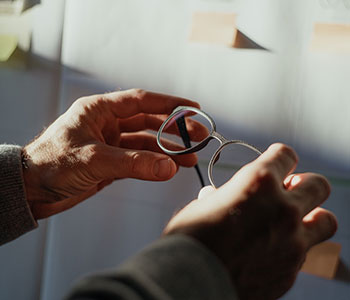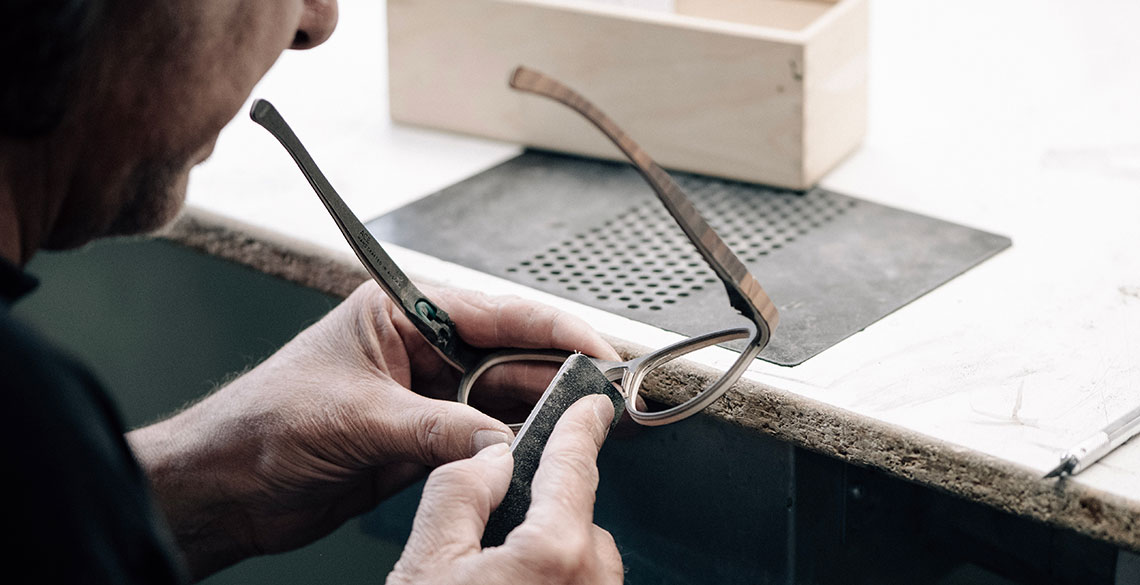Once it is clear that glasses are needed (as a visual aid or even with blue light filters or for the workplace), it is a matter of finding the right glasses. And this means not only the frame, but also the size of the glasses. Because depending on the shape of your face, some sizes of glasses are flattering while others are inappropriate. In this article you will learn what to look for in different sizes of glasses, which measurements are relevant for glasses and how to find the right size for you.
What you find here!
Highest goal: Optimal wearing comfort and harmonious overall appearance
Eyeglass sizes, also called lens sizes, are the dimensions of eyeglass lenses. They are specified in millimeters and usually include the width and height of the glasses. If you already own glasses that are the right size for you, but want to buy a new pair, you can easily find out the measurements. Namely, you can read the lens width, bridge width and temple length on the temples of your current glasses. On the inside of the temples or on the nose bridge are the millimeter specifications. These are internationally standardized. These units of measurement crucial for comfort.
The size of the lenses is important to ensure that they fit well into the frame and that they fully cover the wearer’s eyes. The right sizes of glasses then create an overall aesthetic look. Thus, lens height and width determine the effect of the glasses. Eyeglass sizes may vary depending on the frame and type of glasses. For example, the lenses in reading glasses are usually smaller than the lenses in sunglasses or varifocals. There are small, medium and large glasses. The frame of the glasses is also available in different sizes depending on the eyewear trend. The size of the lenses may also depend on the strength of the prescription, which is determined by an ophthalmologist or optician.


What sizes of glasses fit me?
You don’t have glasses with measurements to guide you and are unsure what size might fit you? In this case, a few pieces of information are important. Because not all sizes of glasses fit all face shapes. There are certain sizes of glasses that are better suited for certain face shapes. For example, glasses with round lenses are suitable for faces with an angular shape, while glasses with angular lenses are more suitable for round faces. The size and shape of the face also play a role in choosing the size of glasses. For example, if your face is very wide or very narrow, it might make sense to choose a larger or smaller frame to make sure the glasses fit well.
So, depending on what shape of face you have, you will also be more likely to go for large or smaller, round or square frames so that they can fit your face perfectly. This is described in more detail in the article “Which shape of glasses suits me?“. But the most important thing is that the glasses fit well and are comfortable to wear, so you can wear them all day long.
Crash course glasses measurements
The following measurements are essential to find out the ideal glasses size for you:
- Glasses width: This should roughly match the width of your face.
- Lens width and height: These measurements are the field of view through the glasses. The lenses should be as wide as the face and not rest on the cheeks.
- Nose bridge width: The bridge should fit the width of the nose. Otherwise it will slip or cause pressure points.
- Temple length: It is crucial for the secure fit of the glasses. If they get too long, the glasses slip. If it is too short, it puts pressure on the temples, ears or nose.


How do I find the perfect size glasses?
There are a few things you should keep in mind here:
- Your facial girth: Measure your facial girth, because it indicates how wide your face is. You should always measure at the widest point, which is usually above the cheekbones.
- Your face shape: This is crucial when choosing the size of your glasses.
- The distance between your eyes: this is important to make sure that the lenses of the glasses fit your eyes exactly.
- The type of nose you have: the size and shape of your nose can also play a role in choosing eyeglass sizes. If your nose is wider or longer, it may be wise to choose a larger frame to ensure the glasses fit well.
- Your eyebrows: The position and size of your eyebrows is also important to consider. If your eyebrows are high or low, you may want to choose a larger or smaller frame so that your eyebrows are still visible.
If all this is too tedious for you, you can of course ask for advice in one of the ROLF stores. Usually, after a referral from your ophthalmologist or optometrist, the sizes of the lenses on the prescription are checked there first. It is important that they are the right sizes of glasses to ensure that they work optimally and are comfortable to wear. After that, your face will be measured and suggestions will be made for a suitable frame that will meet your vision care needs.
And
As always, you decide what you like and what suits your type.







